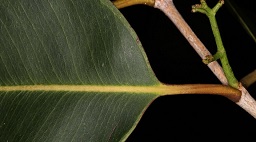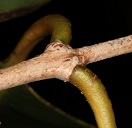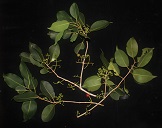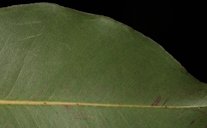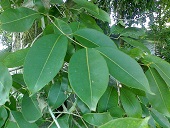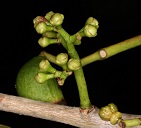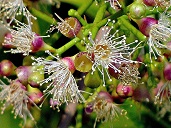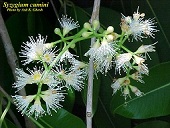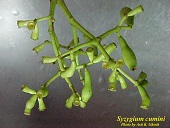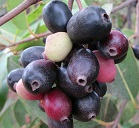| Java Plum, Jambolan - Syzygium cumini | |||||||||||||||||||||||||||
|---|---|---|---|---|---|---|---|---|---|---|---|---|---|---|---|---|---|---|---|---|---|---|---|---|---|---|---|
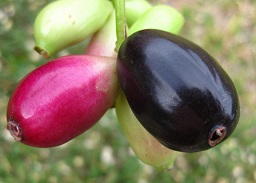 Fig. 1  Syzygium cumini 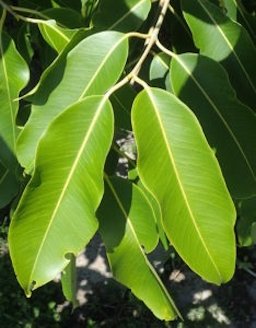 Fig. 2 Terminal leaves are always in pairs 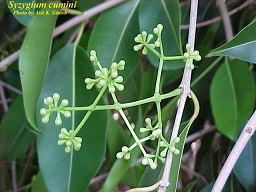 Fig. 9  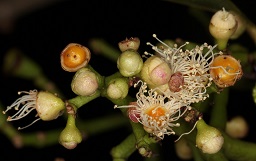 Fig. 10  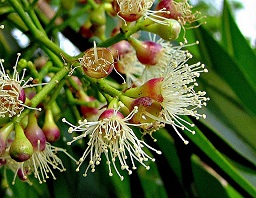 Fig. 11  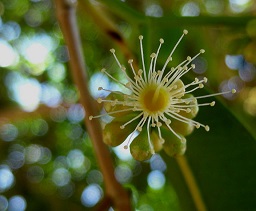 Fig. 12  Picture of a flower of S. cumini taken against the sun. This tree of Asian origin produces quite tasty fruits. 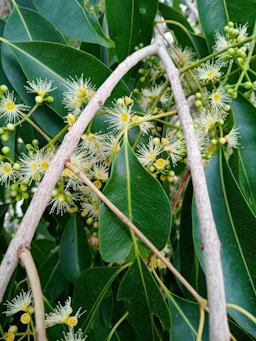 Fig. 13  S. cumini, Bangalore, India 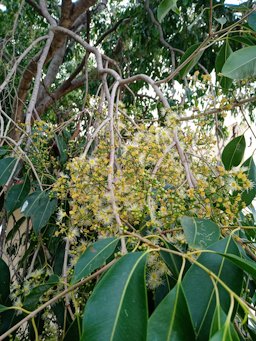 Fig. 14  S. cumini, Bangalore, India 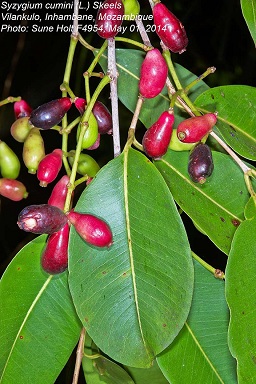 Fig. 18  S. cumini (L.) Skeels, Vilankulo, Inhambane, Mozambique 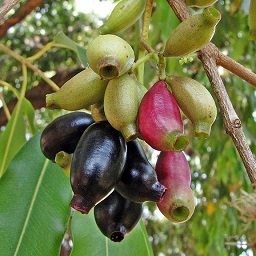 Fig. 19  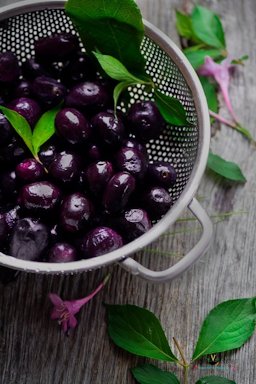 Fig. 24  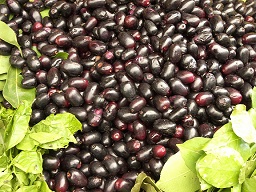 Fig. 25  Ripe fruits for sale in a HAL market in Bangalore 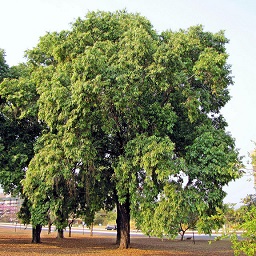 Fig. 26  Jambolão (S. cumini) 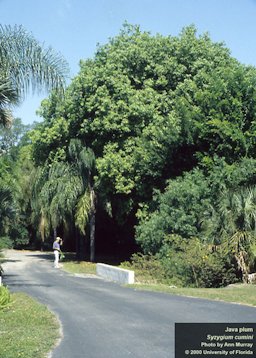 Fig. 27  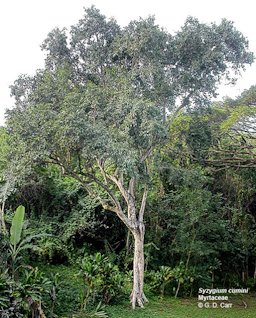 Fig. 28  Tree from E. Indies and Burma, with white flowers and purple to black, globose, edible fruit. Location: Mauka of Biomed; Mānoa Str., Diamond Head of Hale Aulima. 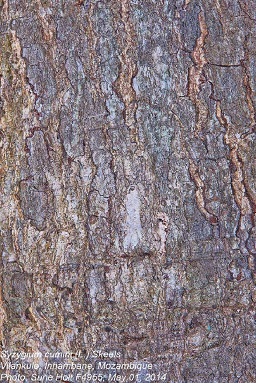 Fig. 29  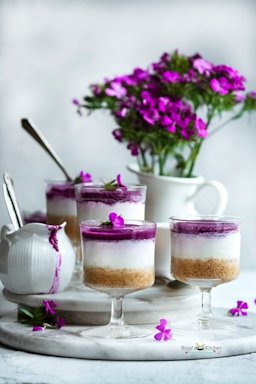 Fig. 30  No bake Jamun cheesecakes  Fig. 31  Jamun ice cream (black plum ice cream). 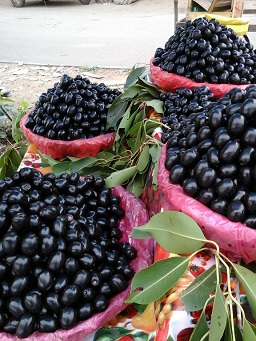 Fig. 32  Fruit for sale in local market |
Scientific
name Syzygium cumini (L.) Skeels Pronunciation sizz-ZYE-gee-um KOU-mee-nee 9 Common names Burmese: thabyang hpyoo; Chinese: hai nan pu tao, hei mo shu, wu kou shu, wu mu; English: black plum, damson plum, duhat plum, jambolan, jambolan plum, Java plum, Malabar plum, Portuguese plum; Frebcg: faux pistachier, jambolon, jambolanier, jamelonguier, jam ongue, prune de Java; German: jambolanapflaume, wachsjambuse; Hindi jamun, jamun beej; Italian: aceituna dulce; Japanese: janboran, murasaki futo momo; Khmer: pring bai, pring das krebey; Laotian: va; Malay: jambhool, jamblang (Indonesia), jambul, jambulan, jambulana, jumbul, jiwat, juwet (Bali), doowet (Indonesia), djoowet (Indonesia); Nepalese: jaambu, jaamun, kaalo jaamun, phaniir; Portuguese: azeitona da terra (Brazil), jambol, jambolao (Brazil), jambul , jamel (Brazil), jal , murta (Brazil); Spanish: ciruelo de Java, jambol (Costa Rica), jambolana, guayabo pesgua, guayabo p jua (Venezuela), p jua extranjera (Venezuela), yambolana; Tagalog: duhat, lomboi, lomboy, Lunaboy; Thai: hakhiphae, look hwa, ma ha, hwa (wa, Waa) 13 Synonyms Calyptranthes jambolana Willd., Caryophyllus jambos Stokes, Consolida major Gilib., Eugenia cumini (L.) Druce, E. djouat Perr., E. jambolana Lam., Myrtus cumini L., S. jambolana D.C., S. jambolanum (Lam.) DC. 4,13 Family Myrtaceae (myrtle family) Origin Africa, Asia -temperate and Asia-tropical 4 USDA hardiness zones Tropical and subtropical climates Uses Nectar is of real value in apiculture; wind-resistant, sometimes it is closely planted in rows as a windbreak 5 Height Up to 40-50 ft (12-15 m) 1,9 Spread 36 ft (11 m) 1 Crown 18-40 ft (5.5-12 m) 9 Plant habit Forks in multiple trunks a short distance from the ground 5 Growth rate Fast growing Longevity It can live more than 100 years 8 Trunk/bark/branches Multi-trunk; bark on lower part rough, cracked, discolored; smooth and light gray further up 5,9 Pruning requirement Removing basal branches and sprouts; keep the size manageable for harvesting Leaves Turpentine-scented; evergreen; pinkish when young; leathery, dark green when mature 5 Flowers Blooms principally in Feb., March; in axillary or terminal panicled cymes; cream, fragrant 1,3 Fruit Oblong, ovoid; described as drupaceous; green when unripe; color changes from pink to black as it matures 8 Season Fruiting extends through late May, June and July 5 USDA Nutrient Content pdf Light requirement Sun Soil tolerances Despite its ability to thrive in low, wet areas, the tree does well on higher, well-drained land whether it be in loam, marl, sand or oolitic limestone 5 Drought tolerance Tolerant of drought when mature Cold tolerance Young trees will not tolerate frost Plant spacing 32-39 ft (12-14 m) as ornamentals; 19.7 ft (6 m) for a windbreak 11 Invasive potential * South: invasive Central, north: not a problem species Pest resistance Fruit fly can be a problem Known hazard Berry can color the tongue purple Reading Material Jambolan, Fruits of Warm Climates Java Plum, Okeechobee News, University of Florida Jamun Syzigium cumunii, Fruitipedia Origin The jambolan is native in India, Burma, Ceylon and the Andaman Islands. 5 Indian emigrants brought it overseas from India and it is common in former tropical British colonies. It has been introduced in Cook Islands, Fiji, French Polynesia, Guam, Hawai‘i, Florida, New Caledonia, Niue, Palau, Tonga, China, Indonesia, Malaysia, Christmas Island, Australia, Africa, India, Caribbean, and South America. It was introduced to Florida in the 1920s. 10 Description The S. cumini trees can reach full height in 40 years, which in their native rage is near 100 feet. In Florida it is half that. It can have a crown 18 to 40 feet wide and often has multiple trunks radiating from near the ground. The Jambul can also grow in wet and dry areas as long as it has sun. 9 Leaves The turpentine-scented evergreen leaves are opposite, 2 to 10 in. (5-25 cm) long, 1 to 4 in. (2.5-10 cm) wide; oblong-oval or elliptic, blunt or tapering to a point at the apex; pinkish when young; when mature, leathery, glossy, dark-green above, lighter beneath, with conspicuous, yellowish midrib. 5 S. cuminii is never leafless in moist localities; the coppery new leaves start even before the old leaves fall. However, in dry localities, it becomes leafless for a short time in the hot season. 11 Terminal leaves are always in pairs (Fig. 2). 9
Fig. 8. Jambhul (S. cumini) leaves of Jambhul tree on Rozoda road at Chinawal village, Maharashtra, India Fig. 7. Java Plum S. cumini, Fort Myers, FL, US Flowers The fragrant flowers, in 1-to 4-in (2.5-10 cm) clusters, are 1/2 in (1.25 cm) wide, 1 in (2.5 cm) or more in length; have a funnel-shaped calyx and 4 to 5 united petals, white at first, then rose-pink, quickly shed leaving only the numerous stamens. 5
Fruit The fruit, in clusters of just a few or 10 to 40, is round or oblong, often curved; ½ to 2 in. (1.25-5 m) long, and usually turns from green to light-magenta, then dark-purple or nearly black as it ripens. A white-fruited form has been reported in Indonesia. The skin is thin, smooth, glossy, and adherent. The pulp is purple or white, very juicy, and normally encloses a single, oblong, green or brown seed, up to 1 ½ in. (4 cm) in length, though some fruits have 2 to 5 seeds tightly compressed within a leathery coat, and some are seedless. The fruit is usually astringent, sometimes unpalatably so, and the flavor varies from acid to fairly sweet. 5 The seed in each berry is strongly astringent and slightly bitter, 1-2 cm long; sometimes 2-5 angular, irregularly shaped seeds are compressed together into a mass resembling a single seed. Cotyledons are pale green. 12 Fruit matures in 90 days. 6 Jamun fruits are highly perishable. They can be stored only up to 2 days at ambient temperature. Precooled fruits packed in perforated polythene bags can be stored for 3 weeks at 8-10 C and 85-95% humidity. 7 Fruits change their colour from green to deep red or bluish black. This is a non climacteric fruit hence it des not ripen after harvesting. Fully ripe fruits are harvested daily by hand picking or by shaking the branches and collecting the fruits on a polythene sheet. Jamun trees need a number of pickings, since all fruits do not ripen at a time. 7
Fig. 20. Close up of the fruit forming Fig. 21. S. cumini - young fruits - ഞാവൽപ്പഴങ്ങൾ മൂക്കാത്തത് Fig. 23. S. cumini fruits in various stages of ripeness Varieties The common types of jambolan in India are: 1) Ra Jaman, with large, oblong fruits, dark-purple or bluish, with pink, sweet pulp and small seeds; 2) Kaatha, with small, acid fruits. Among named cultivars are, mainly, 'Early Wild', 'Late Wild', 'Pharenda'; and, secondarily, 'Small Jaman' and 'Dabka' ('Dubaka'). In Java, the small form is called Djoowet kreekil; a seedless form is Djoowet booten. In southern Malaya, the trees are small-leaved with small flower clusters. Farther north, the variety called 'Krian Duat' has larger, thicker leaves and red inner bark. Fruits with purple flesh are more astringent than the white-fleshed types. 5 Harvesting In India, the fruits are harvested by hand as they ripen and this requires several pickings over the season. Indian horticulturists have reported a crop of 700 fruits from a 5-year-old tree. The production of a large tree may be overwhelming to the average homeowner. 5 Pollination Jamun is a cross- pollinated crop. Hence keeping of honey-bees near the plantation is beneficial for maximum fruit set and productivity. 7 Propagation Natural regeneration is profuse around the mother trees, as the seeds fall in large quantities. Germination takes place on moist ground; each fruit may produce from 1-4 (max. 5) seedlings clustered together in dense masses. 11 It propagates easily from fresh seed, and coppices and resprouts readily. S. cumini begins bearing fruit when 8–10 years old. Seeds lose their viability quickly after maturation. Seedlings grow slowly the first year, rapidly thereafter, and may reach 12 ft (3.65 m) in 2 years, and begin bearing in 8 to 10 years. Grafted trees bear in 4 to 7 years. 5 Culture It prospers on river banks and has been known to withstand prolonged flooding. Yet it is tolerant of drought after it has made some growth. Dry weather is desirable during the flowering and fruiting periods. It is sensitive to frost when young but mature trees have been undamaged by brief below-freezing temperatures in southern Florida. 5 Pruning Young plants need training for the development of framework, keep the main stem or trunk clean up to a height of 60-90 cm from the ground level by removing the basal branches and sprouts. Jamun plants do not require any pruning except removing diseased, dry and crisscross twigs. 7 Pests In Florida, some jambolan trees are very susceptible to scale insects. The fruits are attacked by fruit flies and are avidly eaten by birds. 5 Diseases Diseases recorded as found on the jambolan by inspectors of the Florida Department of Agriculture are: black leaf spot (Asterinella puiggarii); green scurf or algal leaf spot (Cephaleuros virescens); mushroom root rot (Clitocybe tabescens); anthracnose (Colletotrichum gloeosporioides); and leaf spot caused by Phyllosticta eugeniae. 5 In Goa and the Philippines, jambolans are an important source of wine, somewhat like Port, and the distilled liquors, brandy and "jambava" have also been made from the fermented fruit. Jambolan vinegar, extensively made throughout India, is an attractive, clear purple, with a pleasant aroma and mild flavor. 5 Food Uses Jambolans of good size and quality, having a sweet or subacid flavor and a minimum of astringency, are eaten raw and may be made into tarts, sauces and jam. Astringent fruits are improved in palatability by soaking them in salt water or pricking them, rubbing them with a little salt, and letting them stand for an hour. All but decidedly inferior fruits have been utilized for juice which is much like grape juice. 5 The fruit is among the most popular fruit in the Philippines. Good quality jambolan juice is excellent for sherbet, syrup and “squash”. In India, the latter is a bottled drink prepared by cooking the crushed fruits, pressing out the juice, combining it with sugar and water and adding citric acid and sodium benzoate as a preservative. The juice also makes a delicious and excellent red wine, “tinto dulce”. 14 Medicinal Properties ** Jamun fruits are a good source of iron and are said to be useful in the troubles of heart and liver. The seeds of jamun are an effective medicine against diabetes and their powder is widely used in India to control diabetes. 7 Other Uses The jambolan tree is of real value in apiculture. The flowers have abundant nectar and are visited by bees (Apis dorsata) throughout the day, furnishing most of the honey in the Western Ghats. The essential oil distilled from the leaves is used to scent soap and is blended with other materials in making inexpensive perfume. Jambolan bark yields durable brown dyes of various shades depending on the mordant and the strength of the extract. The bark contains 8 to 19% tannin and is much used in tanning leather and preserving fishing nets. 5 The wood is water resistant. Because of this it is used in railway sleepers and to install motors in wells. It is sometimes used to make cheap furniture and village dwellings though it is relatively hard to work on. 8 It is also used for building bridges and for making musical instruments, especially guitars. 12 General As is often the case the botanical name is Greek tainted by Latin. Syzygium is said to refer to the tree’s paired leaves, one also sees “twin” leaves. The base word, however, is zygos (zi-GHOS) the yoke. A person’s spouse in Greece is called my Zizigos (ZEE-zee-ghos) my yoke mate. So the Greek speaker would be strongly tempted to pronounce Syzygium as zee-ZEE-ee-yum. Anglicized Latin would have it sizz-ZYE-gee-um. The species name cumini, said KOU-mee-nee, is from the Greek kyminon (KEY-mee-on) or in modern Greek Kymino (KEY-mee-no) meaning the spice cumin. 9 The jambolan plays an important role in the practices of many Asian cultures and religions. The tree is venerated by Buddhists and also commonly planted near Hindu temples that venerate Krishna. The leaves and fruits are employed in worshipping the elephant-headed god Ganesha. 15 Other Edible Sysygium Species: Malay Apple, S. malaccense Rose Apple, S. jambos Wax Jambu, S. samarangense 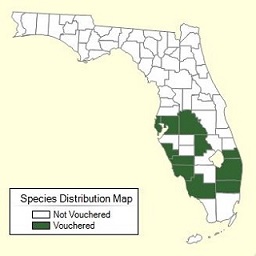 Fig. 33  Distribution map of S. cumini Further Reading Syzygium cuminii (L.) Skeels, Agroforestree Database Syzygium: A Jumble of Jambul, Eat The Weeds List of Growers and Vendors |
||||||||||||||||||||||||||
| Bibliography 1 "Java Plum. "Encyclopedia of Life, EOL, eol.org/pages/2508660/details. Accessed 3 June 2018. 2 DeFilipps, et al. "Medicinal Plants of the Guianas." Smithsonian National Museum of Natural History Department of Botany, 2004, botany.si.edu/bdg/medicinal/index.html. Accessed 3 June 2018. 3 Culbert, Daniel F. “Java Plum.” Feature Article for Okeechobee News, 4 Aug. 2004, 2018, UF/IFAS, Okeechobee Extension Service, okeechobee.ifas.ufl.edu. 4 "Taxon: Syzygium cumini (L.) Skeels." U.S. National Plant Germplasm System, npgsweb.ars-grin.gov/gringlobal/taxonomydetail.aspx?36128. Accessed 7 June 2018. 5 Fruits of Warm Climates. Julia F. Morton, Miami, 1987. 6 Martin, Franklin W., et al. “Perennial Edible Fruits of the Tropics, An Inventory.” United States Department of Agriculture, Agricultural Research Service, Agriculture Handbook no. 642, Apr. 1987, hdl.handle.net/2027/uva.x001754764. Accessed 10 June 2018. 7 Parmar, Chiranjit. "Jamun, Zyzygium cumuni." Encyclopedia of the Edible Fruits of the World, www.fruitipedia.com/jamun.htm. Accessed 10 June 2018. 8 "Syzygium cumini." Wikipedia, en.wikipedia.org/wiki/Syzygium_cumini. Accessed 10 June 2018. 9 Deane, Green. "Syzygium: A Jumble of Jambul." Eat the Weeds and other things, too. www.eattheweeds.com/syzygium-a-jumble-of-jambul-2/. Accessed 10 June 2018. 10 "Syzygium cumini. Java Plum." Encyclopedia of Life, EOL, eol.org/pages/2508660/overview. Accessed 10 June 2018. 11 "Syzygium cumini (L.) Skeels." db.worldagroforestry.org//species/properties/Syzygium_cumini. Accessed 12 June 2018. 12 Orwa C., et al. "Syzygium cuminii (L.) Skeels." Agroforestree Database: a tree reference and selection guide, version 4.0, 2009, www.worldagroforestry.org/treedb2/speciesprofile.php?Spid=1576. Accessed 12 June 2018. 13 The Encyclopedia of Fruit & Nuts. Edited by Jules Janick and Robert E. Paull, Cambridge, CABI, 2008. 14 Lim T. K. "Edible Medicinal And Non-Medicinal Plants: Volume 3, Fruits." EPDF, 2012, epdf.pub/volume-3-fruits.html. Accessed 24 June 2021. 15 Blancke, Rolf. "Jambolan, jambul, Syzygium cumini (L.) Skeels." Tropical Fruits and Other Edible Plants of the World: An Illustrated Guide, Zlibrary, 2016, b-ok.cc/book/3414166/f1bf9d?dsource=recommend. Accessed 24 June 2021. Photographs Fig. 1 Rulkens, Ton. "The fruits of Syzygium cumini (jambolão in Portuguese) are black when ripe. Pemba, Mozambique, Africa." Flickr, 18 Dec. 2010, (CC BY-SA 2.0), www.flickr.com/photos/47108884@N07/5270747237. Accessed 3 June 2018. Fig. 2 Deane, Green. "Terminal leaves are always in pairs." Eat the Weeds and other things, too, www.eattheweeds.com/syzygium-a-jumble-of-jambul-2/. Accessed 10 June 2018. Fig. 3 Cerlin Ng. "Syzygium cumini." Flickr, 13 Aug. 2017, (CC BY-NC-SA 2.0), www.flickr.com/photos/89906643@N06/26688007587/. Accessed 10 June 2018. Fig. 4 Cerlin Ng. "Syzygium cumini." Flickr, 13 Aug. 2017, (CC BY-NC-SA 2.0), www.flickr.com/photos/89906643@N06/41515589362/. Accessed 10 June 2018. Fig. 5 Cerlin Ng. "Syzygium cumini." Flickr, 13 Aug. 2017, (CC BY-NC-SA 2.0), www.flickr.com/photos/89906643@N06/26688006527/. Accessed 10 June 2018. Fig. 6 Cerlin Ng. "Syzygium cumini." Flickr, 13 Aug. 2017, (CC BY-NC-SA 2.0), www.flickr.com/photos/89906643@N06/26688007687. Accessed 21 June 2021. Fig. 7 Valenti, Cassie. "Java Plum Syzygium cumini. " iNaturalist, Research Grade, Shetland Ln, Fort Myers, FL, US, 13 Mar. 2021, (CC BY-NC 4.0), www.inaturalist.org/observations/71159017. Accessed 23 June 2021. Fig. 8 ABHIJEET. "Jambhul (Syzygium cumini) leaves of Jambhul tree on Rozoda road at Chinawal village, Maharashtra, India." Wikimedia Commons, 17 Sept. 2014, (CC BY-NC 3.0), commons.wikimedia.org/wiki/File:Jambhul_tree_leaves_2.jpg. Accessed 10 June 2018. Fig. 9,17,20 Ghosh, Asit K. "Syzygium cumini." Atlas of Florida Plants, [S. M. Landry and K. N. Campbell (application development), USF Water Institute.] Institute for Systematic Botany, University of South Florida, Tampa, florida.plantatlas.usf.edu/Photo.aspx?id=8263. Accessed 6 June 2018. Fig. 10 Cerlin Ng. "Syzygium cumini." Flickr, 13 Aug. 2017, (CC BY-NC-SA 2.0), www.flickr.com/photos/89906643@N06/26688008597/. Accessed 10 June 2018. Fig. 11 Mercadante, Mauricio. "Syzygium cumini MYRTACEAE, Local: Brasília, Brasil." Flickr, 25 Sept. 2010, (CC BY-NC-SA 2.0), www.flickr.com/photos/mercadanteweb/5063331507/. Accessed 6 June 2018. Fig. 12 Rulkens, Ton. "Picture of a flower of S. cumini taken against the sun. This tree of Asian origin produces quite tasty fruits."Flickr, 29 Nov. 2010, (CC BY-SA 2.0), www.flickr.com/photos/47108884@N07/5228729410/in/photostream/. Accessed 3 June 2018. Fig. 13,14 Manoj, Anjali. "Syzygium cumini, Bangladore, India." iNaturalist, Research Grade, 26 May 2020, (CC BY-NC 4.0), www.inaturalist.org/observations/71159017. Accessed 23 June 2021. Fig. 15 Cerlin Ng. "Syzygium cumini." Flickr, 13 Aug. 2017, (CC BY-NC-SA 2.0), www.flickr.com/photos/89906643@N06/40663786665/. Accessed 10 June 2018. Fig. 16 Mercadante, Mauricio."Syzygium cumini MYRTACEAE, Local: Brasília, Brasil." Flickr, 25 Sept. 2010, (CC BY-NC-SA 2.0), www.flickr.com/photos/mercadanteweb/5063332033/. Accessed 6 June 2018. Fig. 18 Holt, Sune. "Syzygium cumini (L.) Skeels, Vilankulo, Inhambane, Mozambique." Flora of Zimbawe, 1 May 2014, (CC BY-NC 3.0), eol.org/data_objects/30284794. Accessed 3 June 2018. Fig. 19 Mercadante, Mauricio. "Syzygium cumini MYRTACEAE, Local: Brasília, Brasil." Oct. 2010, (CC BY-NC-SA 2.0), www.flickr.com/photos/mercadanteweb/5063911366/in/photostream/. Accessed 6 June 2018. Fig. 21 Vinayaraj. "Syzygium cumini - young fruits - ഞാവൽപ്പഴങ്ങൾ മൂക്കാത്തത് ." Wikimedia Commons, 23 Mar. 2008, (CC BY-SA 3.0), commons.wikimedia.org/wiki/File:Syzygium_cumini_-_young_fruits.jpg. Accessed 6 June 2018. Fig. 22 A junaid alam khan. "S. cumini fruits in various stages of ripeness." Wikipedia, 17 Sept. 2010, Public Domain, en.wikipedia.org/wiki/Syzygium_cumini#/media/File:Kalo_jaam.JPG. Accessed 6 June 2018. Fig. 23 satish nikam. "Fruits." Tropical Plants Database, (CC BY-NC-SA 2.0), tropical.theferns.info/image.php?id=Syzygium+cumini. Accessed 10 June 2018. Fig. 24 "Jamun Ice Cream (Black Plum Ice Cream)." Binjal's Veg Kitchen, 1 June 2016, (CC BY-NC-ND 4.0), binjalsvegkitchen.com/jamun-ice-cream-black-plum/. Accessed 21 June 2021. Fig. 25 Rajesh dangi. "Ripe fruits for sale in a HAL market in Bangalore." Wikipedia, 24 June 2007, (CC BY 2.5), en.wikipedia.org/wiki/Syzygium_cumini#/media/File:Ripe_jamun_fruits.jpg. Accessed 6 June 2018. Fig. 26 Mercadante, Mauricio."Syzygium cumini MYRTACEAE, Local: Brasília, Brasil." Flickr, 25 Sept. 2010, (CC BY-NC-SA 2.0), www.flickr.com/photos/mercadanteweb/5063927164/. Accessed 6 June 2018. Fig. 27 Murray, Anne. "Syzygium cumini."UF/IFAS Assessment of Non-native Plants in Florida's Natural Areas, 2000, assessment.ifas.ufl.edu/assessments/syzygium-cumini/. Accessed 6 June 2018. Fig. 28 Carr, G. D. "Syzygium cumini, Myrtaceae, Java plum, jambolan plum. Tree from E. Indies and Burma, with white flowers and purple to black, globose, edible fruit. Location: Mauka of Biomed; Mānoa Str., Diamond Head of Hale Aulima." University of Hawai'i, Botany Dept., www.botany.hawaii.edu/faculty/carr/images/syz_cum_8049.jpg. Accessed 6 June 2018. Fig. 29 Holt, Sune. "Syzygium cumini (L.) Skeels, Vilankulo, Inhambane, Mozambique." Flora of Zimbawe, 1 May 2014, (CC BY-NC 3.0), eol.org/data_objects/30284793. Accessed 3 June 2018. Fig. 30,31 "No Bake Jamun Cheesecakes." Binjal's Veg Kitchen, 19 June 2020, (CC BY-NC-ND 4.0), binjalsvegkitchen.com/no-bake-jamun-cheesecakes/. Accessed 21 June 2021. Fig. 32 "Fruits for sale in a local market." Tropical Plants Database, (CC BY-NC-SA 2.0), tropical.theferns.info/image.php?id=Syzygium+cumini. Accessed 10 June 2018. Fig. 33 Wunderlin, R. P., et al. "Syzygium cumini distribution map." Atlas of Florida Plants. [S. M. Landry and K. N. Campbell (application development), USF Water Institute.] Institute for Systematic Botany, University of South Florida, Tampa, 2018, florida.plantatlas.usf.edu/plant.aspx?id=338. Accessed 6 June 2018. * UF/IFAS Assessment of Non-native Plants in Florida's Natural Areas ** Information provided is not intended to be used as a guide for treatment of medical conditions. Published 12 June 2018 LR. Last update 25 June 2021 LR |
|||||||||||||||||||||||||||
